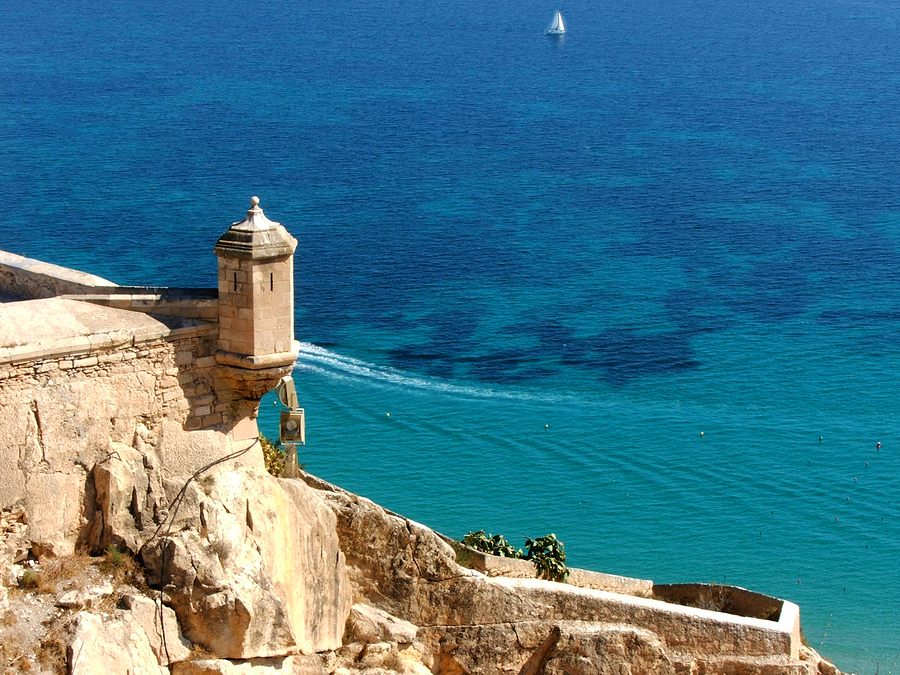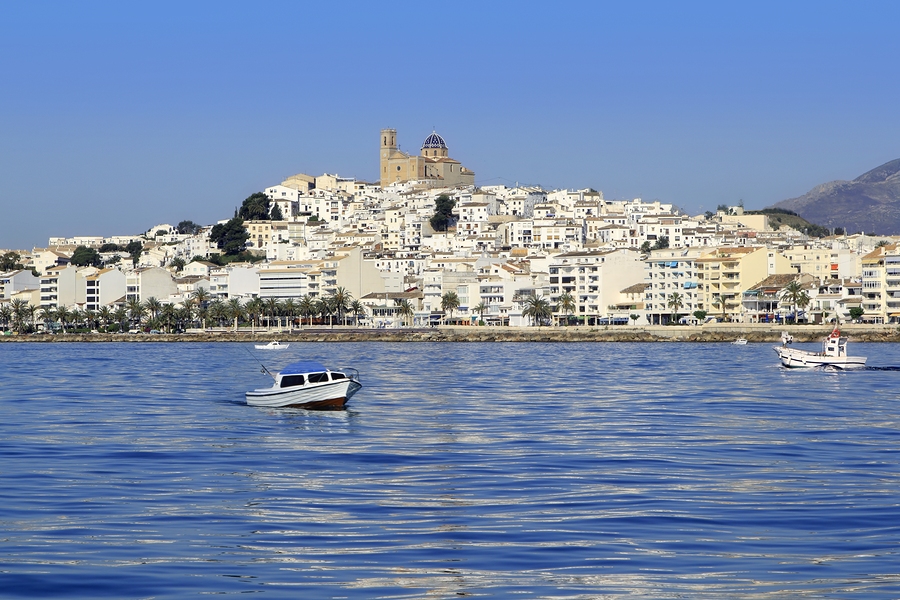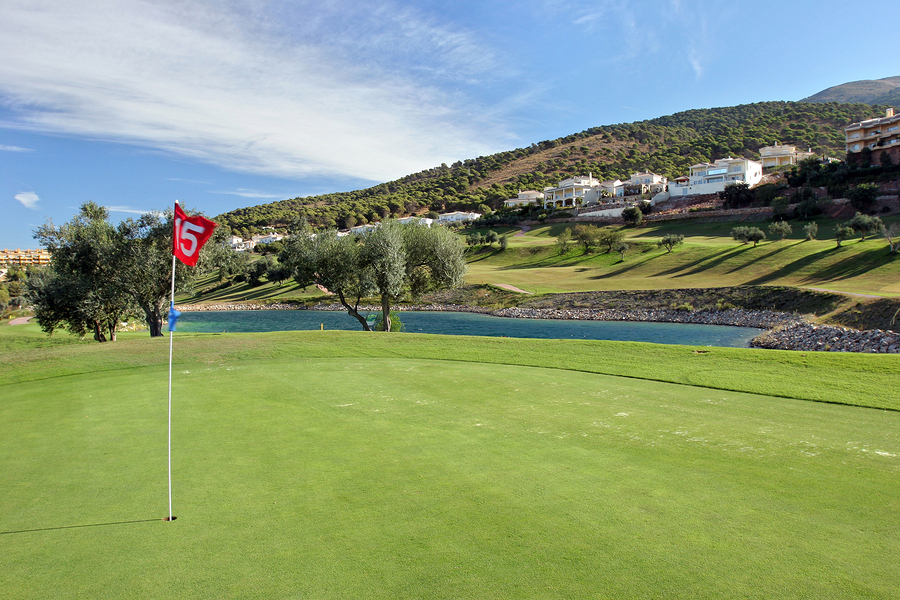Alicante on the Costa Blanca
Alicante in Spain is the gateway to the sun-bleached sands of the Costa Blanca and the tourism mecca of Benidorm. Many Brits actually spend their winter months there to enjoy the balmy climate and the Spainish way of life.
Alicante overlooks the dazzling sands of the Costa Blanca – a city of Roman ruins and fairytale gothic castles. Lying in the heart of the perpetually warm province of Valencia, Alicante is surrounded by gorgeous panoramas of lush green orchards, scented citrus groves and rice paddies presided over by dramatic mountain ranges, towering craggy peaks, cascading river valleys and whitewashed fishing pueblos. Summer fun seekers flock to the sandy playgrounds of Benidorm and yet just a little further north peaceful flower-filled plazas are the perfect spot for sunset cocktails and magnificent views from the tops of the cliffs over the seas to shimmering Ibiza on the horizon.
Weather in Alicante
One of Spain’s sunniest regions, Valencia enjoys year round warmth with over 300 days of sunshine a year and an average yearly temperature of 20°C. The summer months from May to October are the warmest, the hottest months of July and August seeing temperatures that can sometimes rise to highs of 40°C. Temperatures remain mild throughout the winter, rarely falling below 16°C but with just a little more chance of rain.
Alicante
A great choice for a short sunshine break, there’s plenty to do in Alicante from a tour around the ramparts, dungeons and turrets of Santa Bárbara castle to restful relaxation on the beautiful sands of the Playa de Postiguet just beneath. The extravagantly marbled Explanada de España is one of Alicante’s most popular promenades; sweeping around the harbourside towards the flower-filled cobbled streets and tapas bars of the old quarter and there’s excellent shopping in the department stores and traditional markets of the city’s main street the Rambla de Méndez Núñez.
San Juan, Alicante
The resort of San Juan lies some 8 kilometres to the north of Alicante and boasts some of the best sands in the area on its 7 kilometre Blue Flag stretch of beach. San Juan lies on the coastal tram route making it handy for all the attractions and nightlife of the centre of Alicante just 10 minutes or so to the south. A promenade backs the beach and is lined with plenty of restaurants, cafés and bars whilst the historic town of San Juan itself is just a little inland with plenty of shops, monuments, monasteries, a Saturday market and excellent golf courses nearby including Alicante Golf near the beach and Bonalba in Muchamiel.
Benidorm
Benidorm is without doubt the summer playground of the Costa Blanca, its major attractions the infamous buzzing nightlife and spectacular beaches. These two huge sweeping crescents of sand stretch for over 5 kilometres and are known as Levante and Poniente – translated as sunrise and sunset (or east and west). Both beaches are fringed by high-rise hotels, international restaurants, trendy cafés, tapas bars and pleasant promenades where you can stroll well into the evening. Family attractions are also plentiful counting amongst them Terra Mitica and the Aqualandia Water Park. As dark falls Benidorm comes alive with pulsating nightclubs, pubs and bars all open till past dawn.
Altea
The charming village of Altea perches atop a steep hillside, its cobbled streets, whitewashed houses and flower-filled plazas looking out across the Mediterranean. A traditional fishing village and popular retreat for artists and writers, Altea’s picturesque setting boasts harbourside restaurants and bars, craft shops, art galleries and a golf course nearby. The narrow gauge railway links the resort to Benidorm just 15 minutes to the south and then further on to Alicante.
Denia
Backed by the Montgo Mountains and overlooked by its 12th Century castle, Denia is an attractive resort town with wide flat sands, pebble beaches and small rocky coves many of which boast Blue Flag status. Delightful cobbled streets, whitewashed houses and an evening fish market are preserved in the old fisherman’s quarter and elsewhere there are marinas, plenty of boutique shops, outdoor markets, international restaurants, bars, cafés and excellent golf courses nearby. The resort also enjoys good connections with Alicante 2 hours to the south by narrow gauge railway and frequent daily ferries to Ibiza, journey time just 2 and 1/2 hours.
Family fun in Alicante
The beaches of Valencia are consistently voted amongst the most popular beaches in Europe. Many have been awarded blue flags by the European Union including Alicante’s two main beaches of Playa de Postiguet right next to the port and the 7km long beach of San Juan a short tram ride from the city centre. For a quieter beach try the rocky coves to the north of Postiguet around Albufereta or the sands of Playa Urbanova or El Saladar Beach just a short drive south of the city.
Children will not want to miss the spectacular shows and thrilling rides of the Terra Mitica, Paramount’s themed pleasure park of daredevil rides and past recreations of the world’s glorious ancient civilisations in 5 distinct lads of adventure – Egypt, Greece, Rome, Iberia and The Islands. Terra Mitica lies just on the outskirts of Benidorm and its main attractions include the new Synkope revolving discus, Magnus Colossus, the longest wooden rollercoaster in Europe as well as over 20 live shows.
The enormous Aqualandia Water Park lies at the north end of Playa Levante in the centre of Benidorm. Fast adrenaline rush rides include the Kamikaze, Black Hole and Big Bang plus there’s a huge Atlantic wave pool, springboards, gentle raft rides plus the calm waters, waterfalls and caves of paradise beach.
Next door to Benidorm’s Aqualandia visit Mundomar Park where you can join in the dolphinarium show or see turtles, flamingos, seals, penguins and sea lions. There’s also a children’s park with climbing walls, slides and nets, glass bottom boat rides and an underwater galleon for viewing the dolphins.
Take a boat trip from Alicante or Santa Pola over to the small island of Tabarca, once a refuge of Berber pirates and just 15 kilometres off the coast. Less than 2 kilometres long and only 400 metres at its widest point Tabarca has just one hotel and no cars but offers peace, tranquillity, traditional fish restaurants, beautiful walks around its entire coastline and snorkelling and glass bottom boat tours in the crystal clear seas. The island’s offshore waters are an underwater marine preserve with boating, fishing and scuba diving all prohibited.
El Palmeral de Elche is the largest date palm plantation in Europe, laid out at the end of the 10th Century and a UNESCO World Heritage Site since 2000. The groves with over 200,000 trees lie a short drive south of Alicante where visitors can stroll through the park and the beautiful Huerto del Cura.
Out & about in Alicante
From Alicante El Altet airport route C6 buses run every 40 minutes direct to the centre of Alicante where they terminate at Plaza Del Mar. Catch the C6 from bus stop 30 just across the road from the arrivals hall, cost €1 per person one way and journey time 30 – 40 minutes approx. There is also a bus service from the airport direct to Benidorm. The Benidorm bus departs at 09.00, 13.00, 17.00 and 21.00 with 4 additional departures at 08.00, 11.00, 15.00 and 19.00 during the summer months, journey time 60 – 75 minutes approx. Benidorm buses also depart from bus stop 30 opposite the arrivals hall and cost €14 per person return.
Taxis from the Alicante airport are plentiful although queues can be lengthy during the summer months. For journeys from the airport expect to pay €20 approx to the centre of Alicante, €55 – 65 to Benidorm, €60 – 70 to Torrevieja, €90 approx to Murcia, €100 approx to Denia. Car hire companies with airport collection facilities inside the terminal building include Atesa, Auriga, Avis, Centauro, Goldcar Europa, Europcar, Hertz, Record and Sol-Mar. Book online or call beforehand to arrange reservations and pick ups.
Approximate distances from Alicante El Altet Airport are as follows:-
Alicante 12 kilometres
Altea 65 kilometres
Benidorm 60 kilometres
Calpe 70 kilometres
Denia 105 kilometres
Javea 70 kilometres
Torrevieja 60 kilometres
Valencia 150 kilometres
Villajoyosa 45 kilometres
For a day trip along the coast take the narrow gauge railway that runs from Alicante north to Benidorm and Denia. Trains depart from the FGV train station at the north end of Alicante harbour every hour to Benidorm and Altea and every 2 hours to Denia, calling at El Campello, Villajoyosa, Benidorm, Altea, Calpe, Teulada, Denia and all stops in between. Journey time from Alicante to Benidorm 70 minutes, cost €6 per person return; to Denia 2 and 1/2 hours, cost €12 per person return.
At Alicante’s MARQ museum there’s an innovative and interesting approach to archaeology that earned it the 2004 European Museum of the Year award, admission just €3 per person. Alicante also has a number of good art galleries with entrance free of charge. These include the Capa Collection of sculptures amongst the gardens of Santa Bárbara Castle, MUBAG displaying fine arts in the majestic 18th Century Gravina Palace and La Casa de la Asegurada, a comprehensive collection of 20th Century modern art.
Alicante’s Roman origins lie in the remains of the excavated city of Lucentum. This ancient city was the precursor to the modern day coastal city of Alicante, the city walls dating from the 3rd Century BC. The site of Lucentum is found on the hill known as Tossal de Manises in Albufereta and there you can view remains of its walls, streets, buildings and thermal baths. The journey from Alicante to Albufereta on the coastal tram will take about 10 minutes.
Any visit to the provincial capital of Valencia should definitely include some time in one of the most breathtaking projects of the new millennium – the futuristic City of Arts and Sciences. This superb attraction features a planetarium, science museum, aquarium with dolphin show, botanical gardens, outdoor sculptures and arts theatre. Admission tickets are valid for 2 days, cost €30.50 per adult, €23.10 child 4 – 12yrs (extra charge for Titanic – The Exhibition currently on display)
Rising dramatically above Calpe’s two beaches of Arenal and Levante, the spectacular Peñon de Ifach is reputedly the largest single rock in the Mediterranean and symbol of the Costa Blanca. It has been a nature reserve since 1987 with hiking paths up to the 322m high summit. An easier way to the top is via a tunnel carved through the cliff face to gentler slopes with some scrambling required. It’s worth the climb for the breathtaking views sometimes stretching as far as Ibiza on a clear day.
The Moorish town of Guadalest has a population of only 200 but is considered one of the country’s most popular attractions, gouged out of the mountain peaks amidst truly spectacular scenery and gaining its nickname of Eagle’s Nest. Tunnels lead to the castle village and the fortress towers above the valley below with some simply breathtaking views across to the Bay of Altea.
Alicante sports scene
The Costa Blanca boasts a number of excellent golf courses and a superb climate in which to enjoy the beautiful course greens and fairways. Amongst the top names are the La Sella Club at Denia designed by Jose Maria Olazabal, championship Jack Nicklaus courses at Real de Faula near Benidorm and the Oliva Nova course between Denia and Javea designed by Seve Ballasteros. Other courses are scattered along the coastal resorts and include Club Ifach near Calpe and Moraira, Bonalba near Alicante, Javea Golf Club, Altea Golf Club and the Golf and Country Club Marquesa near Santa Pola and Guardamar.
Watersports facilities on the Costa Blanca are excellent. Strong winds and warm waters create ideal conditions for windsurfing with schools along the entire coastline and San Juan an especially popular spot. Elsewhere you’ll find jet-skiing, water skiing, parasailing, surfing and snorkelling in Benidorm and all the main resorts.
The mountain peaks of the Sierra Aitana and the Sierra Serrella are the perfect terrain for road cycling, mountain biking and wilderness walking holidays. At the heart of this surprisingly unspoilt region and yet just an hour from the coast are the mountain villages of Abdet and Quatretondeta both excellent bases with challenging summit ascents, mountain passes, gorges, forest tracks, ancient Moorish trails and flatter ‘greenway’ trails along the converted railway lines.
The limestone peaks and crags of the Costa Blanca provide some of Spain’s best adventure climbing with excellent sunny conditions throughout the year including winter. Top names for climbers are Sella and Toix in the Guadalest Valley and further south the Costa Blanca’s highest mountain, Puig Campana.
The sport of scuba diving has recently become much more accessible on the Costa Blanca with the opening of a large number of PADI dive centres. Geological characteristics between Denia and Benidorm have created an area crammed with underwater caves, caverns, arches and tunnels whilst further offshore lie a number of famous deep sea wrecks including the Sirio, at 60m depth often described as the Titanic of the Mediterranean and for which a dive permit is required. Many of these wreck dives necessitate a higher degree of experience with some quite difficult conditions.
Alicante shopping & dining
Alicante’s main shopping is in the Rambla de Méndez Núñez, a palm-fringed pedestrian street notable for its huge Spanish department stores including El Corte Inglés, and colourful processions during Alicante’s fiesta season. At the top end of La Rambla is the art deco building of the Mercado Central (Central Market), each morning alive with its fragrant flower market and a bustling 2-storey meat and fish market.
Alicante’s shopping malls include Gran Via, Plaza Mar 2 near Playa Postiguet and the 24-hour Panoramis complex on the harbour side of the marina complete with restaurants, bars multi screen cinema complex and ferry boat transport from the beach.
Swaying palms line Alicante’s flamboyant Explanada de Espana, a favourite for evening paseos followed by delicious feasting on spanish nibbles or tapas including Serrano ham, spicy chorizo, albóndigas (meatballs), mejillones (mussels), tortilla (potato omelette) and small salted fish or boquerones. The staple ingredient of Valencian cuisine is rice of which there are supposedly over 300 different varieties. Valencian paella is famous the world over comprising rice, chicken, rabbit, seafood, peppers and greens. Other popular rice dishes are caldero, a clear fish soup and ollas or olletas – substantial stews of rice, game, pulses and vegetables. Wash down with fragrant muscatel wine from the little village of Lliber or bubbly cava from Requena.
Local desserts include la boba (soft sponge cake), turrón (a nougat concoction of almonds and honey), dates from Elche and chocolates, a speciality of Villajoyoso. To finish off enjoy another Alicante favourite, Fondillón, a sweet amber dessert wine or refreshing iced lemon.
Alicante nightlife
Alicante’s main clubbing areas are in El Barrio, the old quarter that comprises the winding streets beneath the Santa Bárbara Castle, further west around the Avenida de Ramón y Cajal where the more sophisticated bars and clubs congregate and the Ruta de la Madera that lies behind the Central Market running parallel to the Avenida de Alfonso El Sabio.
What’s new in Alicante
Spain’s Regional Heritage body has just revealed the location of a sunken Roman wreck off the Costa Blanca coastline near Villajoyosa. The ship, whose structure is almost intact, carries around 2,000 amphorae of preserved foods and other goods and is believed to be one of the most important archaeological finds in the Mediterranean. Protection against ransacking will now be crucial as the vessel is excavated and preserved for museum display, a process that is estimated will take about 10 years.
Alicante calendar
Valencia Las Fallas 15 – 19 March annually
A week of fireworks and bonfires engulfs the city of Valencia as huge papier mache caricatures of famous characters are built, paraded and displayed across the city before being burnt to the ground on the night of 19 March, the night of St Joseph, patron saint of carpenters.
Alicante Las Hogueras 20 – 24 June annually
The entire city of Alicante joins in the lively festival of Las Hogueras (Bonfires) de San Juan that celebrates the summer solstice. Fireworks are launched from the summit of Santa Bárbara Castle and throughout the city there are parades, bullfights, parties and bonfires in the streets and on the beach.
Festival of the Moors and Christians March – December annually
The popular Festival of the Moors and Christians is celebrated throughout the year across the province of Valencia. Parades and festive street carnivals culminate in lavish costumed battle re-enactments between the two armies. Each village celebrates its own heroes; Villajoyosa re-enacts the Christian defence of the town against Moorish pirates in July whilst in Calpe, October is the month of celebration with beach battles, music, fireworks and feasting. Within Alicante each district celebrates a particular battle on separate dates during the year with a final mammoth battle commemorated on 6 December.
Latest posts by Martin Lock (see all)
- Unleash Your Ride: The MiRiDER One Electric Folding Bike Review - April 29, 2024
- The Magical Northern Lights of Tromsø - February 8, 2024
- Property Protection Trust - June 9, 2023
- Land of the Thunder Dragon - November 1, 2022
- 48 hours in Beijing - October 24, 2014
























